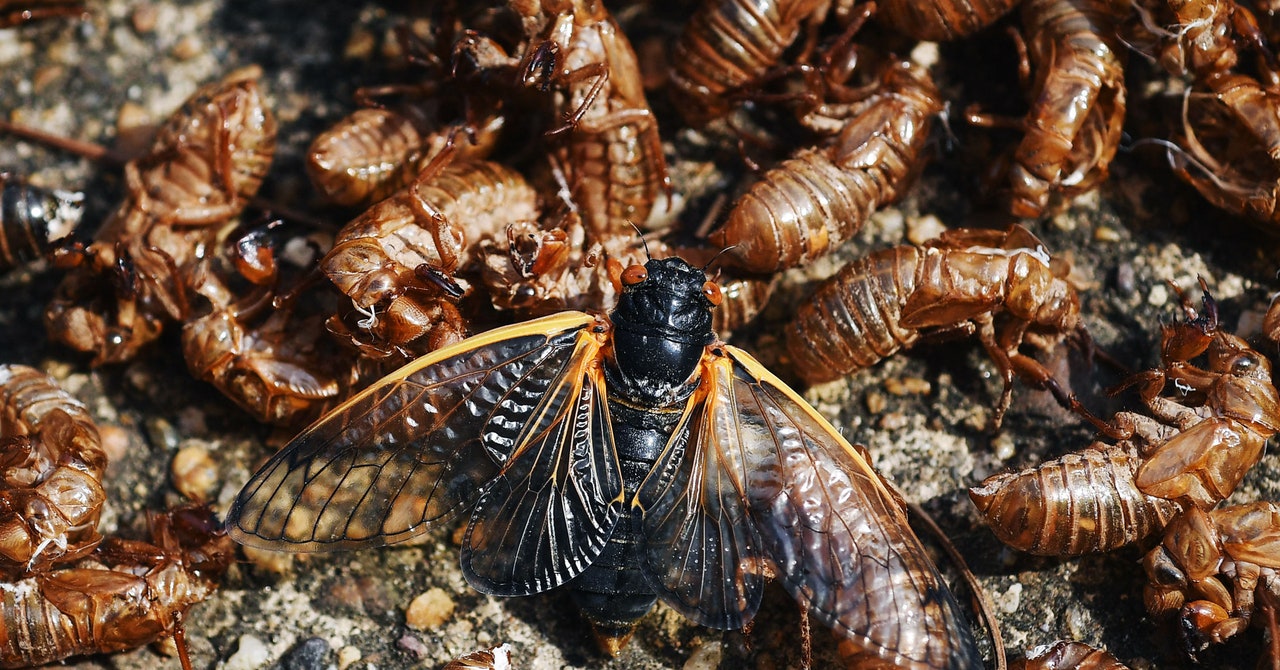
From a distance, the trunk of the big maple appears to be plastered with brown leaves, or perhaps a bad case of acne. But get closer and the bumps form a caravan of living creatures, all doing their best to climb to safety in the branches above.
These are cicadas that have just come out from subterranean exile, hunkered down for the past 17 years, sucking sap from tree roots as they matured a foot beneath the soil. Today is their big day, their “emergence,” as entomologists call it. After a cold spring, the soil temperature here in suburban Silver Spring, Maryland, has reached 64 degrees: go time. The sun is out and juvenile nymphs crawl out of their holes, look for the nearest tall object—a tree, bush, or piece of patio furniture—to climb. Then they wait as their bodies grow stronger and harden into the mini-Hulks of the insect world. Within a few hours, the cicadas have shed their brown shells and morphed from juveniles to adults. Their bodies darken, their eyes turn a bloodshot red, they develop a set of powerful coppery wings and a desire to mate as quickly as possible.
Across 15 eastern states, the same ritual is underway. Billions of cicadas are emerging this week from Brood X—a population of three separate species (two from the genus Magicicada) that emerge from the ground at the same time. There are a dozen broods of 17-year cicadas and three broods of 13-year cicadas in the eastern US, each appearing in different years. But Brood X (entomologists use Roman numerals) is among the largest and lives the closest to big population centers, like the region between Washington, DC, and New Jersey, and stretches west toward Ohio and Indiana.
Zoe Getman-Pickering, a postdoctoral scientist at George Washington University, is one of a handful of cicada researchers who are taking advantage of the six-week emergence to get as much information as they can about the insects’ weird lifestyle, their unusual gut microbes, and how the massive population boom ripples throughout the eastern forest and suburban ecosystems. Dressed in comfortable jeans and a khaki hiking shirt, and carrying a clipboard and binoculars, Getman-Pickering strolls through a local nature preserve looking at thousands of hatching cicadas.
She has some empathy for their struggles. Like humans after more than a year of Covid-19, they, too, are getting used to being in public again. “After the pandemic, it’s something a lot of people can relate to,” Getman-Pickering says. “They’re coming out to the sunlight blinking, all a little clumsy and awkward, trying to get back into the world.”
She picks up a just-emerged adult and checks its underbelly to see if it’s male or female. Females have a pointy “ovipositor” to lay eggs; otherwise they all look the same.
Getman-Pickering and Grace Soltis, an undergraduate at the University of Maryland, are not just interested in insects—they are also recording which types of birds are feeding on this unexpected bonanza. “What we are predicting is that with all the cicadas coming out, there’s a huge amount of easily available food for the birds,” says Getman-Pickering. “Why do all the work of finding tiny caterpillars when you can get free all-you-can-eat tree shrimp?”
She says bird populations skyrocket as they switch from their normal prey of caterpillars and other small insects to this new buffet. More food for the birds means a better chance of reproduction, and—later—more baby birds.
Indeed, less than an hour after the cicadas have begun their crawl up the big maple, a pair of downy woodpeckers, several tree sparrows, and a crow swoop in and start to feast on the smorgasbord. And it’s not just birds, Getman-Pickering says. “Every animal is eating the cicadas, including rats and dogs if they are not kept in check,” she says. People too.
Video: Eric Niiler
Getman-Pickering spends every day in the field collecting data from sites in suburban Maryland, another more rural wooded area, and a control site without cicadas near the Chesapeake Bay. By comparing their populations of birds and caterpillars, she hopes to sketch out ecological patterns that might remain long after the few weeks the cicadas will be around. “When the birds stop eating caterpillars,” Getman-Pickering says, “the populations of the caterpillars will explode and will potentially do more damage to the trees. We also expect the population of parasitic wasps will increase. They eat the caterpillar inside out, saving the vital organs for last.”


